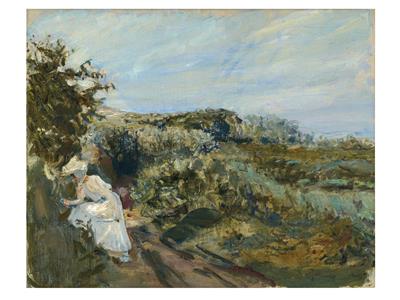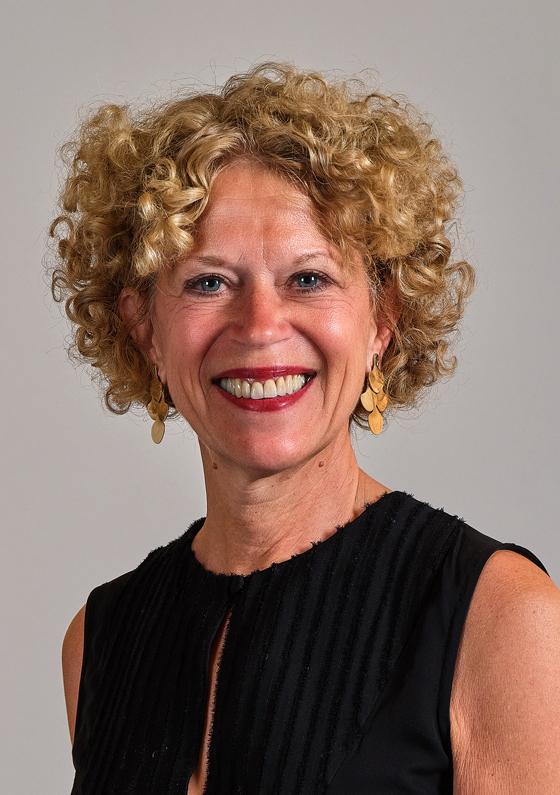Max Slevogt

(Landshut 1868–1932 Neukastel)
Landscape with woman in white, 1908, signed Slevogt, oil on canvas, 65 x 80 cm, framed
The authenticity of the work was confirmed orally by Bernhard Geil, whom we thank for this kind scientific advice.
Provenance:
Private collection, Germany
Exhibited:
Landesmuseum Mainz, Ein Tag am Meer. Slevogt, Liebermann & Cassirer, 9 October 2018–10 February 2019 (see exhibition catalogue, cat. no. 3.6., with ill. on p. 105)
In the summer of 1908, Max Slevogt spent two weeks on the Dutch North Sea coast. Together with his fellow artists Max Liebermann and Lovis Corinth, he stayed at the summer house of his friend, the Berlin art dealer and publisher Paul Cassirer, on the beach at Noordwijk. Cassirer, together with his girlfriend and future wife, the Austrian actress and radio-actress Tilla Durieux, had the holiday home in the middle of the dunes built according to their own ideas. The holiday home in the then up-and-coming Dutch seaside resort of Noordwijk aan Zee was of course also open to Cassirer’s friends, so that the artists he represented as a gallery owner automatically had guest rights. They all belonged to the Berlin Secession artists’ association and formed the triumvirate of German Impressionism. Together, the three artists painted the sea and the beach. Unlike his artist friends, who regularly travelled abroad to paint, Slevogt was reluctant to travel and explored the North Sea coast only once to paint. The subject of the stall landscape is thus very rare in Slevogt’s œuvre. A total of only six paintings of this motif are known and each of these pictures occupies a unique place in his oeuvre.
The “Landscape with a White Lady” comes from this important series of works and shows a lady in a white robe in the lower edge of the picture. The subject’s radiant white summer dress forms a strong colour contrast to the dune landscape in the centre of the composition, which is depicted in various shades of green. The contrast produces tension in the painting. The dialogue between figure and space, determined by the desire to see, is typical of Impressionism. A close-up and seemingly randomly selected section of the landscape is depicted with the female protagonist. It is conceivable that the painting was created during a joint excursion or walk away from the holiday home. The painting was shown in Berlin in 1918 in an exhibition for Slevogt’s 50th birthday. In that exhibition it bore the title “Lady Seeking Blackberries” (Hg. Generaldirektion Kulturelles Erbe Rheinland-Pfalz, bearbeitet von Karoline Feulner, Ein Tag am Meer. Slevogt, Liebermann und Cassirer, p. 16.). Based on the title at the time, it can be assumed that the painting probably shows “the summer pleasure of a blackberry hunt [...]” (Ibid. p. 13). The lady leans slightly forward and seems to be looking for ripe fruit in the bushes. The light plays around the ladies’ back, creating the impression of an intense reflection of the sun. The lady wears a summer hat, also white, which shades her face and reveals only a little of her dark hair. Whether the sitter is Tilla Durieux is unclear. However, the close relationship between Slevogt, Cassirer and his partner Tilla suggests that she might be the subject. Furthermore, according to Slevogt’s handwritten catalogue raisonné, Tilla Durieux is listed as the owner of the painting “Landscape with White Lady” or “Lady Seeking Blackberries” (Cf. ibid, p. 97). Tilla Durieux was born Ottilie Godeffroy in Vienna in August 1880. She was interested in the theatre from an early age and trained as an actress in the city of her birth. Since her parents rejected her choice of profession, she chose the stage name Tilla Durieux. After various stations in Europe, the young actress came to Berlin for the 1903/04 season, where she met the German publisher, art dealer and gallery owner Paul Cassirer and married him as her second husband.
The colours are applied impasto and the palette is bright and very varied. The dunes are composed of fine brushstrokes in numerous shades of green. In the background, the beach and the sea, which blurs with the horizon, can be glimpsed from the viewer’s right.
The painting “Landscape with a White Lady” was only recently rediscovered through the preparations for the exhibition “A Day at the Sea. Slevogt, Liebermann and Cassirer”. It is a unique painting that was to find no successor in this form in Slevogt’s œuvre, for after his stay in Noordwijk Max Slevogt painted no more beach landscapes.
Esperta: Dr. Petra Maria Schäpers
 Dr. Petra Maria Schäpers
Dr. Petra Maria Schäpers
+49 211 2107747
petra.schaepers@dorotheum.de
30.11.2021 - 18:00
- Stima:
-
EUR 90.000,- a EUR 140.000,-
Max Slevogt
(Landshut 1868–1932 Neukastel)
Landscape with woman in white, 1908, signed Slevogt, oil on canvas, 65 x 80 cm, framed
The authenticity of the work was confirmed orally by Bernhard Geil, whom we thank for this kind scientific advice.
Provenance:
Private collection, Germany
Exhibited:
Landesmuseum Mainz, Ein Tag am Meer. Slevogt, Liebermann & Cassirer, 9 October 2018–10 February 2019 (see exhibition catalogue, cat. no. 3.6., with ill. on p. 105)
In the summer of 1908, Max Slevogt spent two weeks on the Dutch North Sea coast. Together with his fellow artists Max Liebermann and Lovis Corinth, he stayed at the summer house of his friend, the Berlin art dealer and publisher Paul Cassirer, on the beach at Noordwijk. Cassirer, together with his girlfriend and future wife, the Austrian actress and radio-actress Tilla Durieux, had the holiday home in the middle of the dunes built according to their own ideas. The holiday home in the then up-and-coming Dutch seaside resort of Noordwijk aan Zee was of course also open to Cassirer’s friends, so that the artists he represented as a gallery owner automatically had guest rights. They all belonged to the Berlin Secession artists’ association and formed the triumvirate of German Impressionism. Together, the three artists painted the sea and the beach. Unlike his artist friends, who regularly travelled abroad to paint, Slevogt was reluctant to travel and explored the North Sea coast only once to paint. The subject of the stall landscape is thus very rare in Slevogt’s œuvre. A total of only six paintings of this motif are known and each of these pictures occupies a unique place in his oeuvre.
The “Landscape with a White Lady” comes from this important series of works and shows a lady in a white robe in the lower edge of the picture. The subject’s radiant white summer dress forms a strong colour contrast to the dune landscape in the centre of the composition, which is depicted in various shades of green. The contrast produces tension in the painting. The dialogue between figure and space, determined by the desire to see, is typical of Impressionism. A close-up and seemingly randomly selected section of the landscape is depicted with the female protagonist. It is conceivable that the painting was created during a joint excursion or walk away from the holiday home. The painting was shown in Berlin in 1918 in an exhibition for Slevogt’s 50th birthday. In that exhibition it bore the title “Lady Seeking Blackberries” (Hg. Generaldirektion Kulturelles Erbe Rheinland-Pfalz, bearbeitet von Karoline Feulner, Ein Tag am Meer. Slevogt, Liebermann und Cassirer, p. 16.). Based on the title at the time, it can be assumed that the painting probably shows “the summer pleasure of a blackberry hunt [...]” (Ibid. p. 13). The lady leans slightly forward and seems to be looking for ripe fruit in the bushes. The light plays around the ladies’ back, creating the impression of an intense reflection of the sun. The lady wears a summer hat, also white, which shades her face and reveals only a little of her dark hair. Whether the sitter is Tilla Durieux is unclear. However, the close relationship between Slevogt, Cassirer and his partner Tilla suggests that she might be the subject. Furthermore, according to Slevogt’s handwritten catalogue raisonné, Tilla Durieux is listed as the owner of the painting “Landscape with White Lady” or “Lady Seeking Blackberries” (Cf. ibid, p. 97). Tilla Durieux was born Ottilie Godeffroy in Vienna in August 1880. She was interested in the theatre from an early age and trained as an actress in the city of her birth. Since her parents rejected her choice of profession, she chose the stage name Tilla Durieux. After various stations in Europe, the young actress came to Berlin for the 1903/04 season, where she met the German publisher, art dealer and gallery owner Paul Cassirer and married him as her second husband.
The colours are applied impasto and the palette is bright and very varied. The dunes are composed of fine brushstrokes in numerous shades of green. In the background, the beach and the sea, which blurs with the horizon, can be glimpsed from the viewer’s right.
The painting “Landscape with a White Lady” was only recently rediscovered through the preparations for the exhibition “A Day at the Sea. Slevogt, Liebermann and Cassirer”. It is a unique painting that was to find no successor in this form in Slevogt’s œuvre, for after his stay in Noordwijk Max Slevogt painted no more beach landscapes.
Esperta: Dr. Petra Maria Schäpers
 Dr. Petra Maria Schäpers
Dr. Petra Maria Schäpers
+49 211 2107747
petra.schaepers@dorotheum.de
|
Hotline dell'acquirente
lun-ven: 10.00 - 17.00
kundendienst@dorotheum.at +43 1 515 60 200 |
| Asta: | Arte moderna |
| Tipo d'asta: | Asta in sala con Live Bidding |
| Data: | 30.11.2021 - 18:00 |
| Luogo dell'asta: | Wien | Palais Dorotheum |
| Esposizione: | Online |
